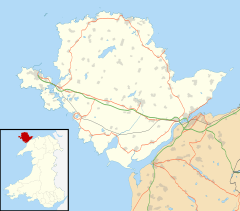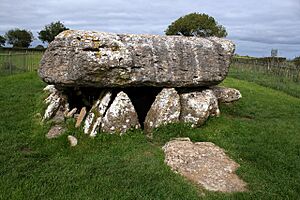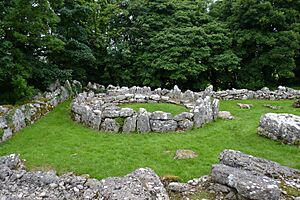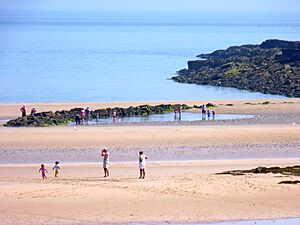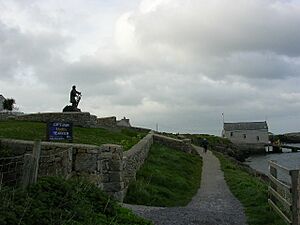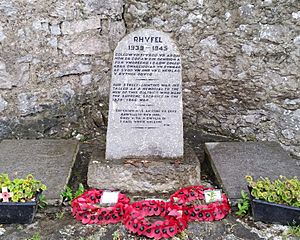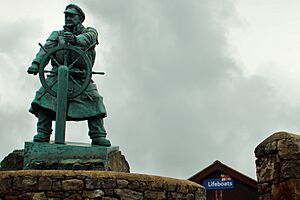Moelfre, Anglesey facts for kids
Quick facts for kids Moelfre |
|
|---|---|
 The harbour-front and seawall, circa 1966 |
|
| Population | 1,064 |
| OS grid reference | SH5186 |
| Principal area | |
| Ceremonial county | |
| Country | Wales |
| Sovereign state | United Kingdom |
| Post town | MOELFRE |
| Postcode district | LL72 |
| Police | North Wales |
| Fire | North Wales |
| Ambulance | Welsh |
| EU Parliament | Wales |
| UK Parliament |
|
| Welsh Assembly |
|
Moelfre is a charming village located on the north-east coast of the Isle of Anglesey in Wales. Its name comes from Welsh words meaning "bald" or "barren hill," describing the land behind it when seen from the sea. This small community includes the main village and harbour, plus other smaller areas nearby.
Moelfre is famous for its rich history, especially its connection to the sea. It used to be a busy fishing port. Since 1854, a brave lifeboat station has been helping people in trouble at sea. Many ships have been wrecked off its coast, including the famous Royal Charter in 1859. Today, you can visit the RNLI Seawatch Centre near the lifeboat station to learn more about these stories.
The coastline around Moelfre is beautiful, with rocky areas and a large sandy beach called Lligwy Bay. The Anglesey Coastal Path runs through here, offering amazing views. In 2011, about 710 people lived in the village.
Contents
Where is Moelfre?
The village of Moelfre is built around a small harbour. A headland and the rocky island of Ynys Moelfre protect the harbour from the north winds. The wider Moelfre community also includes other small settlements like Marian-glas, Llanallgo, Brynrefail, and Mynydd Bodafon.
In 2011, the whole community had a population of 1,064 people. The village itself has about 502 homes. The main road, the A5025, is just a five-minute drive from the village. If you want to travel by train, the nearest stations are in Bangor and Llanfairpwllgwyngyll. You can reach them by bus from Moelfre in under half an hour.
A Look Back in Time
Moelfre has a very long and interesting history, with many ancient sites to explore.
Ancient Discoveries
The Moelfre area has 14 Scheduled Ancient Monuments, which are protected historical sites. This is more than any other place in Anglesey! Most of these sites are from prehistoric times. They include an ancient burial site and a standing stone.
Six of these monuments are Iron Age settlements. This shows that people lived here a long time ago, even before the Romans arrived. Three of these special places are looked after by Cadw, a Welsh government body that protects historic sites. These sites have signs, public access, and information boards. Other ancient monuments might not be easy to see or visit.
Here are some of the interesting ancient sites:
- Ogof Arian Cave: This cave has an inner chamber that goes about 25 meters into the hillside. Tools made of flint from the Neolithic period (New Stone Age) have been found here. It's also known as Smugglers' Cave.
- Lligwy Burial Chamber: This is a huge stone monument from the Neolithic period. It has a giant capstone supported by eight side stones. When it was explored in 1909, archaeologists found many flint tools, pottery, and the remains of 15 to 30 people.
- Plas Bodafon standing stone: This prehistoric stone is 1.3 meters tall and made of a special type of rock called quartzite.
- Bwlch-y-Dafarn Enclosed Hut Group: This site has a rectangular walled area with a well-defined roundhouse inside. Roman pottery was found here, showing it was used during the Roman period.
- Din Lligwy Ancient Village: These are the stone foundations of Iron Age houses and workshops. They are surrounded by a protective wall.
- Capel Lligwy: This is a ruined chapel from the 12th century. It used to be a private place of worship and is now a picturesque ruin without a roof.
- Traeth Lligwy Fish Weir: This is a fish trap made of rocks in a crescent shape near the low-tide mark of Lligwy Bay. It's thought to be from the medieval period. At high tide, it's completely covered, but at low tide, it traps fish.
Shipwrecks and Heroes
The coast near Moelfre has seen many shipwrecks over the years. Strong gales often pushed ships onto the shore.
- The Royal Charter: In 1859, the steam clipper The Royal Charter was wrecked near Moelfre. It was almost at the end of its long journey from Australia to Liverpool. Sadly, about 400 lives were lost. There's a memorial on the headland and an obelisk in Llanallgo Churchyard to remember them.
- The CSS Alabama: In 1862, a ship called the Enrica hid in Moelfre Bay. This ship later became the famous Confederate States of America warship CSS Alabama. It was trying to avoid British officials and another ship sent to catch it.
Many other ships were wrecked here, like the Princess Amelia (1868) and the Kate (1933).
Lifeboats and the Sea
The Moelfre Lifeboat Station has a very brave history. Since 1854, lifeboat crews have been saving lives at sea. One famous rescue was the Hindlea in 1959, when all the crew members were saved.
The lifeboat station is often open to visitors. You can see the Tamar-class lifeboat named Kiwi and the smaller inflatable D-class lifeboat (IB1) called Enfys.
A statue of Richard Evans, a famous lifeboatman who served for 50 years, was put up in 2004. It's outside the Seawatch Museum, which is close to the lifeboat station. The museum shares information about the area and the history of the lifeboats.
Nature Around Moelfre
Near Moelfre, you'll find the sandy beach of Traeth Lligwy and the ancient stone village of Din Lligwy. The nearby island of Ynys Moelfre is a great place to spot birds. You might also see seals and porpoises swimming in the waters.
Things to Do in Moelfre
Moelfre has several places of worship. St Galgo's Anglican Church dates back to the 7th century. Carmel Congregational Chapel was built in 1829. Both have weekly services in Welsh and English. Paradws Chapel is Calvinistic Methodist.
The village has a school called Ysgol Gymuned Moelfre (Community School), which teaches in Welsh. In 2013, there were 63 students. The local library is also in the same building. Moelfre also has a football club, CPD Bro Goronwy, located on School Lane.
Interestingly, the village didn't have street lights until after the Second World War. They were installed as a memorial to the villagers who died in the war.
You can find restaurants, a small shop, and a fish and chip shop in the village. The RNLI Gwylfan Moelfre Seawatch Centre has a small museum, a shop, and a book store where you can learn more about the sea and local history.
Famous People from Moelfre
- Richard Evans (1905–2001) was a brave lifeboatman who served for 50 years.
- Aled Eames (1921–1996) was a historian who studied maritime (sea) history. He lived in Moelfre for a long time.
- John Walter Jones (1946–2020) was the first Chief Executive of the Welsh Language Board from 1993 to 2004.
See also
 In Spanish: Moelfre para niños
In Spanish: Moelfre para niños


